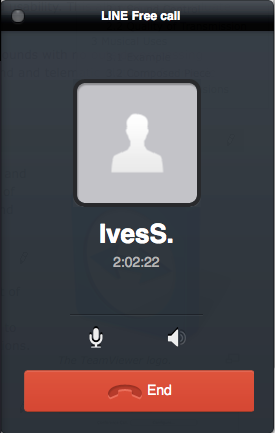LINE
Line is a free voice calling application for smart phones. Besides the trickiness of setting up an account the quality of the application is very impressive. It has not found much popularity in the United States or much of Europe but is very popular in countries like Japan, Taiwan, Thailand, Spain, and Switzerland among some others. The emojis and game attachments seem to be the draw among its users. The user has very little control over the settings of the application because it was meant for smart phone calling. The addition of PC/Mac devices is simply convenience because the accessibility does not improve much.
USERNAME
Ives and I first had trouble just getting in contract with each other because of the fact that Ives does not have a smart phone and you can not sign up from your computer only. He had to download an emulator and download the app and set up an account from his computer. A mobile phone number is needed to create an account which then requires authorization. Even after that, the profile that you have now created can not be seen by others until you make a username that people can search for which we did not figure out for quite some time.
Sound Control
The control that the user is given through line is actually non-existent. We believe that is because the application is based on its smart phone use where the control of levels during a voice call is just volume control. The user can not even select input or output settings or control the volume of the incoming call. All of this had be done through the computer settings. The configurations of input and output that we needed to do our testing proved to be a bit of a challenge because of these restrictions.
Sound Quality
Both of us were very impressed with the quality and latency of the call. Neither of us had a hard time hearing each other or experienced drop off through volume changes or latency. We found that the latency of the application was varying between 50-80 ms which we thought was pretty accurate considering the quality we were hearing. Our first attempt at measuring the latency was accomplished by looping the tone Ives was sending to me back to him through a hard patch from the line in to headphone jacks on my laptop. Considering my (Bo's) basic skills of sound design, once I downloaded SoundFlower we were able to patch the sound in a much cleaner, more efficient way. Since in our set up the sound was being sent from Germany to San Diego and then back to Germany where Ives used his own pd patch to read the latency, we had to split the time in half because of the round trip it was making.
Exploration
We were unsuccessful in our ways to use this software creatively because of our limited time working together and our feeling the quality of the call was good enough that any attempt at playing sound together would sync successfully instead of finding distinct sounds created through its short comings. The lack of user manipulation really left us with a clean and steady video call that would actually be useful in sharing clean sounds from one person to another in another country.



